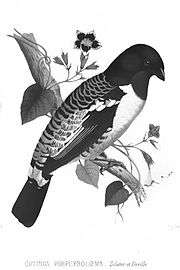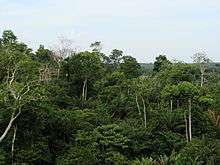Purple-throated cotinga
The purple-throated cotinga (Porphyrolaema porphyrolaema) is a species of bird in the cotinga family, Cotingidae. It is found in the western Amazon rainforest of South America; its range extends from southern Colombia south through eastern Ecuador and Peru and east through extreme northwestern Bolivia and into western Amazonian Brazil. It lives in the canopy or along the borders of humid forest throughout its range. The purple-throated cotinga is monotypic within the genus Porphyrolaema and has no known subspecies. It is one of the smaller cotinga species and expresses strong sexual dimorphism. Males have black upperparts with a bold white wingstripe and white edges to the tertial feathers and a white belly with some black barring on the rear flanks. The throat is a deep purple, giving the bird both its common and scientific names. Females are dark brown with pale buffy margins on the upperparts, buffy cinnamon with black barring on the underparts, and rufous on the throat. The male has a powerful voice.
| Purple-throated cotinga | |
|---|---|
| male at Apiacás, State of Mato Grosso, Brazil | |
| female at same locality | |
| Scientific classification | |
| Kingdom: | Animalia |
| Phylum: | Chordata |
| Class: | Aves |
| Order: | Passeriformes |
| Family: | Cotingidae |
| Genus: | Porphyrolaema Bonaparte, 1854 |
| Species: | P. porphyrolaema |
| Binomial name | |
| Porphyrolaema porphyrolaema | |
 | |
| Green marking the range of the purple-throated cotinga | |
| Synonyms | |
| |
Little research has been done on this species, and not much is known about its ecology. The purple-throated cotinga is primarily frugivorous, although it does occasionally eat small insects. A solitary male attracts a female by perching in the canopy and letting the sunlight reflect off its iridescent feathers. It is suspected to breed year-round and is non-migratory. Despite being considered naturally uncommon or rare across its vast range, the purple-throated cotinga is listed as a species of Least Concern.
Taxonomy
The purple-throated cotinga was originally described in 1852 as Cotinga porphyrolaema by Emile Deville and Philip Sclater from a male specimen collected near the Ucayali River in Peru's Sarayacu District.[2] The holotype is kept at the Jardin des Plantes in Paris.[3] However, just two years later the species was split from the genus Cotinga into the monotypic genus Porphyrolaema by Charles Lucien Bonaparte.[2] The generic and specific name of porphyrolaema comes from the Ancient Greek words porphyros "dark purple," and laimos, "throat."[4]
While it is structurally similar to the Cotinga species, the purple-throated cotinga differs from them in that it has a heavier, stubbier bill, distinctive pale fringing on the back feathers, and barred underparts in the female.[5] While it is still generally considered to be closely related to the Cotinga species, recent molecular analysis has suggested that the species may in fact form a separate clade with other canopy-dwelling cotingas, specifically the neotropical bellbirds of the genus Procnias, the cotingas of the genus Carpodectes, the black-faced cotinga of the monotypic genus Conioptilon, and the bare-necked fruitcrow of the monotypic genus Gymnoderus.[6] Of these genera, the molecular analysis suggested that the purple-throated cotinga was most closely related to the neotropical bellbirds.[6] This cotinga does not have a recognized subspecies.[2]
Description

The purple-throated cotinga is strongly sexually dimorphic as male and female purple-throated cotingas have few similarities in their plumage. The male has black upperparts, including the head, wings, and tail. The feathers on the bird's back to its uppertail coverts, as well as its upperwing coverts, have white fringes. There is also a conspicuous white wingstripe and white edges to the tertial feathers.[7] Additionally the male has a deeply purple throat and a white belly, with some black barring on its rear flanks.[2]
In contrast, the female purple-throated cotinga is a dark brown with pale buffy margins on the upperparts. The underparts are a buffy cinnamon with black barring. The throat is a deeper, unbarred rufous in coloration. The female's tail feathers are longer and more pointed at the tip than those of the male. The juvenile purple-throated cotinga resembles a paler, buffier female; the plumage of the immature is undescribed.[2]
The adult purple-throated cotinga is about 18.0 to 18.5 cm (7.1 to 7.3 in) in length and weighs an average of 49 to 60 g (1.7 to 2.1 oz).[7][8] The cotinga has a very wide bill with a strongly arched culmen and weakly developed rictal bristles. The bird's iris is dark brown, while the bill and legs are black.[2]
This species has a powerful if infrequently-used voice, unlike the structurally-similar Cotinga species, which are mostly silent.[7] The male's call is a high, plaintive "preeeeeer" that lasts for one or two seconds while dropping in pitch and is regularly repeated from a treetop perch.[2][7]
Distribution and habitat

The purple-throated cotinga is found from southern Colombia south through eastern Ecuador and Peru to the Madre de Dios region and east through extreme northwestern Bolivia and into western Amazonian Brazil.[2] The eastern boundary of the species appears to be the lower Rio Negro and northern Mato Grosso in Brazil.[2] The purple-throated cotinga's total range covers approximately 2,190,000 km2 (850,000 sq mi), throughout which it occurs in patches at low population densities.[9]
The cotinga can be found in the canopy or borders of humid forest up to 900 m (3,000 ft) in elevation, but mostly is restricted to humid forests below 400 m (1,300 ft).[2][7] It can be found in either unflooded humid forests or in várzea forests, which are seasonally flooded.[5] It is non-migratory.[9]
Ecology and behavior
The purple-throated cotinga feeds primarily on the fruits of forest trees, most notably those belonging to the genus Cecropia.[2] It also occasionally consumes small invertebrates, such as insects.[8] All reported observations of the species feeding involve the cotinga leaning down from its perch to pluck fruit off a tree in the forest canopy.[2] These birds are distinct from similar species in that they are often seen in pairs.[2] This species perches in the canopy to take in the morning sun.[5]
A solitary male purple-throated cotinga attracts a female by perching above the canopy and letting the sun highlight its iridescent plumage.[8] The breeding behavior of this species is largely unknown, but the range in molting times implies that this species may breed year-round.[2]
Status
The purple-throated cotinga is not well known and appears to be naturally uncommon or rare across a widespread area; however, it is almost certainly under-reported due to its canopy lifestyle.[2] The IUCN considers this species to be a species of Least Concern due in part to its large range.[9] While the IUCN has not estimated the population size, it believes it is declining due to habitat loss.[9]
References
- BirdLife International (2012). "Porphyrolaema porphyrolaema". IUCN Red List of Threatened Species. 2012. Retrieved 26 November 2013.CS1 maint: ref=harv (link)
- Snow 2004, p. 93
- Jardine 1852, p. 129
- Liddell, Henry George; Scott, Robert (1980) [1871]. A Greek-English Lexicon (Abridged ed.). Oxford, United Kingdom: Oxford University Press. pp. 404, 579. ISBN 0-19-910207-4.
- Ridgely 1994, p. 752
- Ohlson, Jan I.; Prum, Richard O.; Ericson, G.P. (2007). "A Molecular Phylogeny of the Cotingas (Aves: Cotingidae)" (PDF). Molecular Phylogenetics and Evolution. Academic Press. 42 (1): 25–37. doi:10.1016/j.ympev.2006.05.041. PMID 16876441.
- Ridgely 2001, p. 549
- Brooks, Daniel M.; Lucio Pando-Vasquez; Angel Ocmin-Petit (1999). "Comparative Life History of Cotingas in the Northern Peruvian Amazon" (PDF). Ornitologia Neotropical. The Neotropical Ornithological Society. 10: 193–206. Archived from the original (PDF) on 2013-12-17..
- "Species factsheet: Porphyrolaema porphyrolaema". BirdLife International. 2013. Retrieved 17 April 2013.
Cited texts
- Jardine, William (1852). Contributions to Ornithology, 1848-1852. London: T.E. Metcalf. p. 130.
Deville & Sclater, 1852.
- Ridgely, Robert S.; Greenfield, Paul J. (2001). The Birds of Ecuador Volume II: Field Guide. Ithaca, NY: Comstock Publishing Associates. ISBN 0-8014-8721-8.CS1 maint: ref=harv (link)
- Ridgely, Robert S.; Guy Tudor (1994). The Birds of South America: The Suboscine Passerines. Singapore: University of Texas Press. ISBN 0-292-77063-4.
- Snow, David W. (2004). "Family Cotingidae (Cotingas)". In del Hoyo, Josep; Elliott, Andrew; Christie, David (eds.). Handbook of the Birds of the World. 9. Cotingas to Pipits and Wagtails. Barcelona: Lynx Editions.
